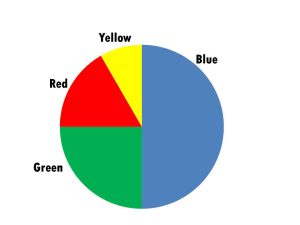Data Handling
Exercise 4.1
1). A survey was made to find the type of music that a certain group of young people liked in a city. The adjoining pie chart shows the findings of this survey. From this pie chart answer the following:

(i) If 20 people liked classical music, how many young people were surveyed?
20 people represent 10%
Let the total number of people surveyed be x
10% X x = 20
x = (20 X 100)/10
x = 2000/10
x = 200
Ans: Total young people surveyed = 200
(ii) Which type of music is liked by the maximum number of people?
Ans: Light music is liked by the maximum number of people.
(iii) If a cassette company were to make 1000 CD’s, how many of each type would they make?
Total CD’s = 1000
Light music = 40% X 1000
= (40 X 1000)/100
= 40000/100
= 400
Folk music = 30% X 1000
= (30 X 1000)/100
= 30000/100
= 300
Classical music = 10% X 1000
= (10 X 1000)/100
= 10000/100
= 100
Semi cClassical music = 20% X 1000
= (20 X 1000)/100
= 20000/100
= 200
2). A group of 360 people were asked to vote for their favourite season from the three seasons rainy, winter and summer.
| Season | No of Votes |
| Summer | 90 |
| Rainy | 120 |
| Winter | 150 |
(i) Which season got the most votes?
(ii) Find the central angle of each sector.
(iii) Draw a pie chart to show this information.
Solution:
(i) Which season got the most votes?
Ans: Winter season got the most votes.
(ii) Find the central angle of each sector.
| Season | No of Votes | Central angle |
| Summer | 90 | 90 |
| Rainy | 120 | 120 |
| Winter | 150 | 150 |
| Total | 360 |
Central angle for summer = (90/360) X 360
= 90
Central angle for Rainy = (120/360) X 360
= 120
Central angle for Winter = (150/360) X 360
= 150
(iii) Draw a pie chart to show this information.

3). Draw a pie chart showing the following information. The table shows the colours preferred by a group of people.
| Colours | No. of People |
| Blue | 18 |
| Green | 9 |
| Red | 6 |
| Yellow | 3 |
| Total | 36 |
Solution:
| Colours | No. of People | fraction | Central Angle |
| Blue | 18 | 18/36 = ½
|
½ X 360 = 1800 |
| Green | 9 | 9/36 = ¼
|
¼ X 360 = 900 |
| Red | 6 | 6/36 = 1/6
|
1/6 X 360 = 600 |
| Yellow | 3 | 3/36 = 1/12
|
1/12 X 360 = 300 |
| Total | 36 |
Central angle for Blue = 1800
Central angle for Green = 900
Central angle for Red = 600
Central angle for Yellow = 300

4). The adjoining pie chart gives the marks scored in an examination by a student in Hindi, English, Mathematics, Social Science and Science. If the total marks obtained by the students were 540, answer the following questions.
(i) In which subject did the student score 105 marks?
(Hint: for 540 marks, the central angle = 360°. So, for 105 marks, what is the central angle?)
(ii) How many more marks were obtained by the student in Mathematics than in Hindi?
(iii) Examine whether the sum of the marks obtained in Social Science and Mathematics is more than that in Science and Hindi.
(Hint: Just study the central angles).

Solution:
(i) In which subject did the student score 105 marks?
(Hint: for 540 marks, the central angle = 360°. So, for 105 marks, what is the central angle?)
For marks 540 the central angle is 360
Therefore, for 105 marks central angle = (360/540 )X 105
= (2/3 )X 105
= 2 X 35
= 700
Corresponding subjet to 700 is Hindi.
(ii) How many more marks were obtained by the student in Mathematics than in Hindi?
Marks obtained in Mathematics = (90/360 )X 540
= (1/40 )X 540
= 1 X 135
= 135
Marks obtained in Hindi = 105
More marks obtained in Mathematics than Hindi = 135 – 105
= 30
(iii) Examine whether the sum of the marks obtained in Social Science and Mathematics is more than that in Science and Hindi.
(Hint: Just study the central angles).
Central angle for Social Science and Mathematics = 65 + 90
= 155
Central angle for Science and Hindi = 80 + 70
= 150
5). The number of students in a hostel, speaking different languages is given below. Display the data in a pie chart.
| Languages | Hindi | English | Marathi | Tamil | Bengal | Total |
| Number of Students | 40 | 12 | 9 | 7 | 4 | 72 |

Click here for the solutions of Std 8 Maths
1). Rational Numbers
2). Linear Equations in One Variable
3). Understanding Quadrilaterals
4). Data Handling
![]()